You Have Just Witnessed One of Hitlers Artworks Meme Hitlers Art
Adolf Hitler is considered one of the nearly infamous and disliked individuals in history. One time he came to power in Germany, the Nazi leader and all who followed him were responsible for millions of deaths, as well as the mass theft of valuable artworks. In that location was another side to him, however, existence Hitler's paintings. Hitler's artworks are a touchy subject as many people consider information technology immoral to buy Hitler'due south paintings. Were Hitler'southward drawings and paintings any skilful? Are paintings by Hitler worth anything today? Let the states explore more than almost the dictator who wanted to pigment.
Table of Contents
- 1 The History of Hitler'south Paintings
- 1.1 Hitler in Vienna
- 1.ii Hitler in Munich
- ane.3 Hitler's Vendetta Against Art
- 2 Hitler's Artwork
- ii.1 Fake Hitler Artworks
- 2.2 Painting as the Führer
- 2.iii The Influences and Manner of Hitler'southward Paintings
- two.four Why Is It So Hard to Verify Hitler's Artwork?
- 2.five Sale Sales
- 2.half dozen Paintings by Hitler
- three The Moral Implications of the Sale of Hitler'south Paintings
- 4 Frequently Asked Questions
- 4.1 What Themes and Subjects Did Adolf Hitler Paint?
- 4.2 Where Are Hitler'south Artworks Now?
The History of Hitler'south Paintings
Hitler ever knew he wanted to be an creative person, even during the early years of his childhood in Linz, Republic of austria. His mother is said to have encouraged him profoundly in his artistic endeavors. His father Alois, however, was a bad-tempered authoritarian who had no desire to see his son go an creative person. Alois disregarded any artistic talent that Adolf Hitler might have had, and frequently physically beat him.
Adamant that his son get a normal and stable career, he enrolled Hitler in technical schoolhouse.
Alois passed abroad a few years subsequently, but despite the temptation he must have felt to go out the schoolhouse, Hitler finished the grade with an average score. After graduating in 1905, Hitler remained with his dying mother in Linz for a couple of years until she died in December of 1907.
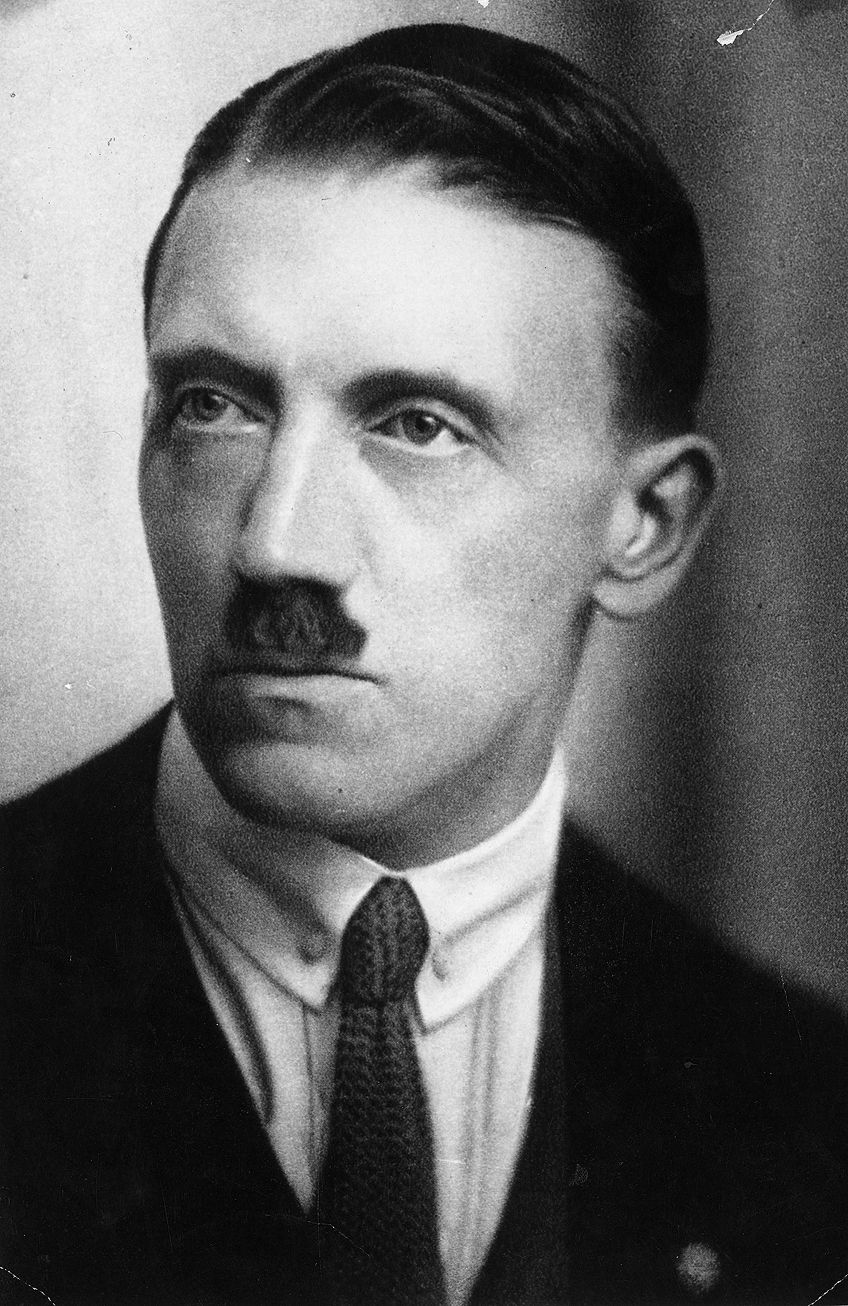 Adolf Hitler as a young homo in the early on 1920s;Unknown author Unknown author, Public domain, via Wikimedia Commons
Adolf Hitler as a young homo in the early on 1920s;Unknown author Unknown author, Public domain, via Wikimedia Commons
Hitler in Vienna
At historic period 18, Hitler moved to the beautiful art capital of the empire, Vienna, which he viewed every bit the perfect place to finally pursue his desire to become an artist. Unfortunately for him, he institute information technology difficult to achieve the success he was after, while his roommate August Kubizek was instantly enrolled into a music solarium.
While nevertheless living in Linz, Hitler had tried to apply to the University of Fine Arts in Vienna. Although he had managed to laissez passer the start exam, the committee of admissions found Hitler'due south drawings to be subpar.
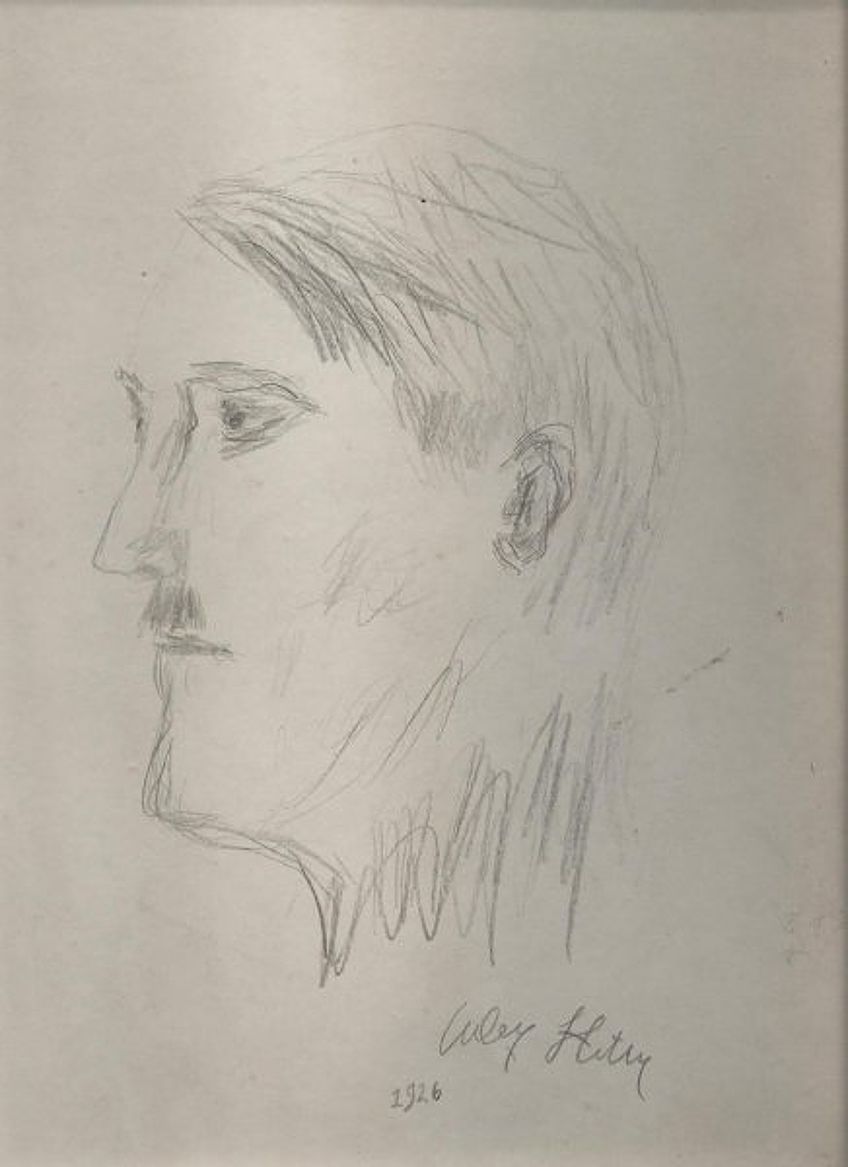 Self-portrait (1926) by Adolf Hitler;Adolf Hitler, Public domain, via Wikimedia Eatables
Self-portrait (1926) by Adolf Hitler;Adolf Hitler, Public domain, via Wikimedia Eatables
Hitler did non take the news well, being notoriously unfavorable of whatsoever sort of rejection. After moving to Vienna, he continued making sketches and mixing with the art customs while doing his studies and earning a wage as a worker.
Hitler's drawings were sent to the Academy of Fine Arts for the 2nd fourth dimension in the autumn of 1908 and were again rejected. His professors urged him to follow his more naturally suited set of skills and enroll at an architectural school instead. They felt that Hitler'south drawings displayed an understanding of architectural construction and design, if not containing any artistic merit.
Hitler did non warm up to this thought at all and was shocked and disappointed that he had been rejected past the bookish heads of art.
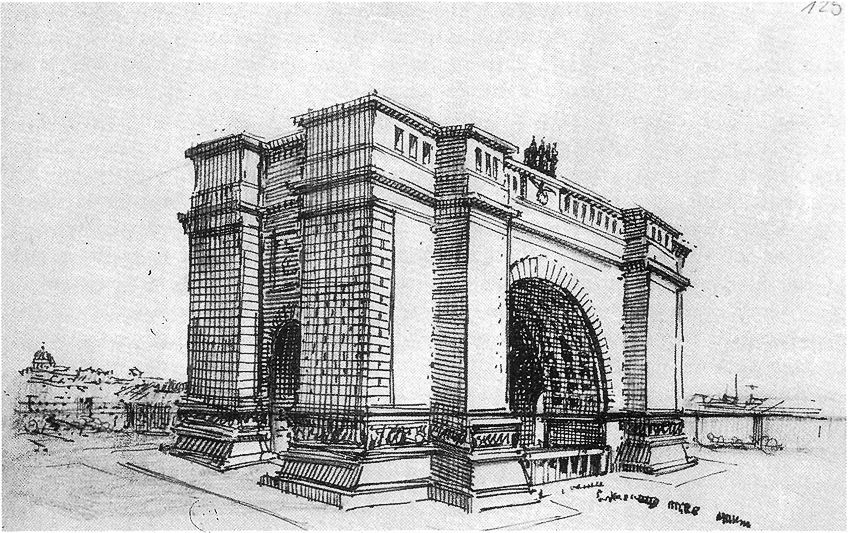 Hitler's ink drawing of the Triumphal Curvation for Germania, 1925. Germania refers to the renewed German language capital letter of Berlin that Hitler envisioned for the time to come of Nazi Federal republic of germany;Adolf Hitler, Public domain, via Wikimedia Commons
Hitler's ink drawing of the Triumphal Curvation for Germania, 1925. Germania refers to the renewed German language capital letter of Berlin that Hitler envisioned for the time to come of Nazi Federal republic of germany;Adolf Hitler, Public domain, via Wikimedia Commons
During this period, Hitler moved residence oft, going from one inexpensive room to some other, and even stayed in a shelter for the destitute for a while. A few recent studies accept suggested that he might have covered most of his living expenses with a loan from his family. Adolf Hitler finally managed to rise above abject poverty in 1909, gaining some momentum by selling oil and watercolor paintings of Vienna cityscapes to foreigners visiting the city.
Many of Hilter'southward paintings were copied from postcards, allowing him to recreate scenes from anywhere at any fourth dimension, simply remained original in content. The sales of Hitler's artwork were enough to afford him a room at a home for men instead of having to stay in a homeless shelter.
It was during this time that Hitler became increasingly interested in politics while becoming all the more frustrated with the fine art world.
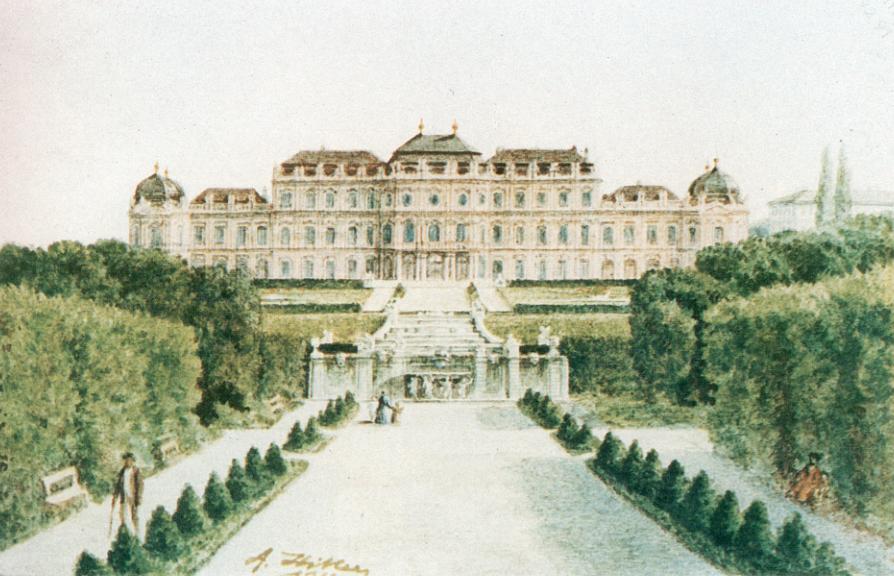 Dais, Vienna(c. 1910) by Adolf Hitler;Adolf Hitler, Public domain, via Wikimedia Eatables
Dais, Vienna(c. 1910) by Adolf Hitler;Adolf Hitler, Public domain, via Wikimedia Eatables
Many historians have suggested that Hitler'southward anti-semitic inclinations started at dwelling, but in his autobiography Mein Kampf, Hitler says that it was during this time in Vienna that his hatred against the Jewish people of Germany began. Historians accept noticed a singled-out contradiction in Hitler's ethos during this menses, even so, as while he was both an avid follower and gentleman of the anti-Semitic Mayor, Karl Lueger, nigh of his work during this time was financed by the Jewish store owner, Samuel Morgenstern.
It has been suggested that he accepted work very reluctantly from Jewish patrons out of sheer desperation.
Hitler in Munich
Hitler then moved to Munich in May of 1913, finding some success in the same manner that he had on the streets of Vienna – by selling oil and watercolors of Munich cityscapes. A few well-off patrons also kept him out of homeless shelters by commissioning many of Hitler's artworks. However, in 1914, this came to an sharp end when the police of Munich managed to rails him downwards for dodging the military typhoon in his hometown of Linz.
However, Adolf would not laissez passer his fitness exam in the armed forces, being declared too weak and unsuitable for combat equally well as incapable of firing a weapon. All the same, later the get-go of the kickoff world war in august, he enrolled voluntarily and his fourth dimension as a struggling artist came to a sudden finish.
 A photograph of Adolf Hitler in Earth War I, c. 1914/1918. He is pictured with his war comrades of the Bavarian Reserve Infantry Regiment 16. You can spot Hitler and his large moustache on the far right of the gentlemen who are sitting;Bundesarchiv, Bild 146-1974-082-44 / CC-Past-SA 3.0, CC BY-SA three.0 DE, via Wikimedia Eatables
A photograph of Adolf Hitler in Earth War I, c. 1914/1918. He is pictured with his war comrades of the Bavarian Reserve Infantry Regiment 16. You can spot Hitler and his large moustache on the far right of the gentlemen who are sitting;Bundesarchiv, Bild 146-1974-082-44 / CC-Past-SA 3.0, CC BY-SA three.0 DE, via Wikimedia Eatables
Hitler's Vendetta Against Art
Both Hitler'south failure to be accepted into the fine art academies as well as the political inclinations he started to lean towards in those early on days in Vienna most definitely had a major influence in creating the nearly mythical persona that would lead him to power. Not merely did he wish to exterminate Jews from the German State, just people of color, homosexuals, Roma travelers, and dissenters of Nazism besides.
He likewise rallied against modern fine art, referring to it as degenerative and a production of the Jews and Bolsheviks. It is non a far stretch to remember that his artistic shortcomings and tastes influenced his views on the subject of modern art.
Around 16,000 artworks considered to exist degenerate past Hitler were seized from various German language Museums by his henchmen in 1937.
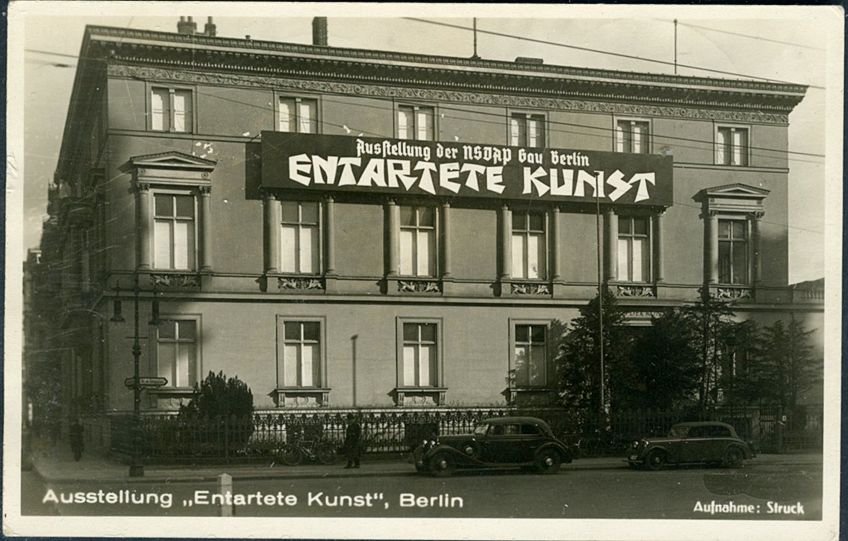 Photograph of Berliner Kunsthalle at Königsplatz 4, the exhibition hall in Berlin for the infamous "Degenerate Art Exhibition" (Entartete Kunst). This was a propaganda exhibition displaying and mocking "united nations-German language and unhealthy" art by Jewish and modern painters and sculptors. The text on the imprint sign on the wall reads: Ausstellung der NSDAP Gau Berlin ENTARTETE KUNST ("Exhibition of the Nazi Party in Berlin district: Degenerate Art"), c. 1938;Uncredited photographer / Struck (Struck-Photo-Postkarte, a defunct German language postcard publishing company), CC BY-SA iv.0, via Wikimedia Commons
Photograph of Berliner Kunsthalle at Königsplatz 4, the exhibition hall in Berlin for the infamous "Degenerate Art Exhibition" (Entartete Kunst). This was a propaganda exhibition displaying and mocking "united nations-German language and unhealthy" art by Jewish and modern painters and sculptors. The text on the imprint sign on the wall reads: Ausstellung der NSDAP Gau Berlin ENTARTETE KUNST ("Exhibition of the Nazi Party in Berlin district: Degenerate Art"), c. 1938;Uncredited photographer / Struck (Struck-Photo-Postkarte, a defunct German language postcard publishing company), CC BY-SA iv.0, via Wikimedia Commons
These included works by famous artists such as Paul Klee and Wassily Kandinsky, as well as works past Jewish artists. Hitler so proceeded to hold a "Degenerate Art" exhibition of these non-representational and abstruse works of modern art. All the same, he did not wish to portray the art positively, and the art was displayed haphazardly and with no intendance, intentionally hanging them skewed and clumped in a very unaesthetic mode.
He wanted the piece of work to be seen every bit revealing the corrupt morals and intentions of the movement.
Actors had even been hired to pretend to exist visitors in the museum and criticize the art while mingling with the crowds. All of this was done to create the impression that modern art was made past degenerates and had no value.
Even though the objective of the exhibition was to influence the public to view the art as disdainful, it attracted around two million viewers before going on tour in Deutschland, expanding the viewership to another 1000000 people at least. Many people attended for the sensational spectacle, others were compassionate towards the Nazi propaganda, while others simply viewed it as potentially the last chance they would get to run across these artworks in person, especially in Germany.
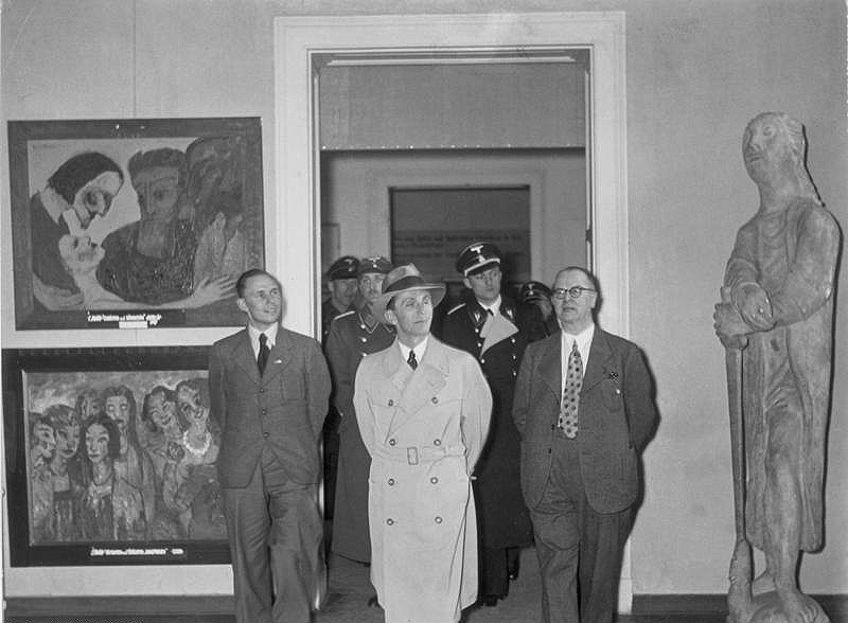 Nazi propaganda minister Joseph Goebbels visiting the "Degenerate Art" exhibition in Munich in 1938;Bundesarchiv, Bild 183-H02648 / Unknown writer Unknown author / CC BY-SA 3.0 DE, CC Past-SA iii.0 DE, via Wikimedia Commons
Nazi propaganda minister Joseph Goebbels visiting the "Degenerate Art" exhibition in Munich in 1938;Bundesarchiv, Bild 183-H02648 / Unknown writer Unknown author / CC BY-SA 3.0 DE, CC Past-SA iii.0 DE, via Wikimedia Commons
Hitler hoped to reflect his personal art tastes to the public by arranging another exhibition that would run at the aforementioned time equally the other simply would be far better curated. The Great German Art Exhibition featured paintings of landscapes, soldiers, and blonde nudes that had been pre-canonical by Hitler, befitting to his ain unoriginal and traditional preferences in art. He envisioned that the exhibit would be critically appraised in comparison to the farcical exhibition he had created of stolen artwork.
This program backfired, however, equally his show was marred by a much lower attendance charge per unit, presumably leaving his ego more than than a lilliputian scrap damaged and delicate.
Hitler'south Artwork
About of Hitler's paintings were plainly destroyed under his command after coming to power in Federal republic of germany. Yet, there are still collections around the world that the Nazis seem to have missed, numbering several hundreds of Hitler paintings. The United states owns 4 of Hilter's watercolors after they were confiscated during the Second Globe War. The largest collection of paintings by Hitler can besides be found in the United states of america at the International Museum of Earth State of war II.
Fake Hitler Artworks
Information technology is legal to sell Hitler'south artwork in Germany as long as the art does not behave any depictions of Nazi symbolism. Hitler'south paintings do, yet, crusade controversy whenever they are put upward for auction. As many as xiv of Hitler's paintings sold for $450,000 at an auction in Nuremberg in 2015, including paintings such as Neuschwanstein and Old Vienna/Hofburg With Old Passage Way.
 Schloss Neuschwanstein (1914) past Adolf Hitler, depicting Neuschwanstein Castle in Upper Bavaria;Adolf Hitler, Public domain, via Wikimedia Eatables
Schloss Neuschwanstein (1914) past Adolf Hitler, depicting Neuschwanstein Castle in Upper Bavaria;Adolf Hitler, Public domain, via Wikimedia Eatables
Despite many people being vehemently opposed to the sale of piece of work that is connected to figures involved in human atrocities, some people, such as those who correspond the auction business firm, have argued that the value lies in their historical significance.
Moral and historical controversies are not the but issues that arise whenever Adolf Hitler'south artwork is put up for auction. The other major problem that arises is forgery and concerns over the authenticity of the apparent paintings past Hitler.
In 2019, iii watercolors that were upwards for auction at the Kloss Business firm in Berlin were confiscated due to suspicion of forgery. They were supposedly Hitler's paintings, containing landscape scenes of mountains and rivers. Each work carried a seal of actuality and was on sale for $4,500 at the auction house. However, police believe that the authenticity seal may take been faked.
Around 1 month later that, another five works that were apparently paintings past Adolf Hitler were on sale at a Nazi Memorabilia sale. The insane prices scared buyers and fueled rumors of fraud, leaving the artworks on the auction block unbought.
Many people, including those who worked for Kloss auction house, stated that Hitler's paintings had no real intrinsic artistic value, but that the loftier asking prices came downward to the name in the corner of the painting.
Painting as the Führer
During his time in reign equally the Führer, Hitler continued to pigment merely did so privately. Critics take remarked that his talent was rather undeveloped, as he lacked professional training and was not able to capture the essence of a scene nor showroom any passion in his work.
Despite his lack of talent, Hitler remained enthusiastic nigh painting as a hobby and considered himself a bit of an skilful on the subject area.
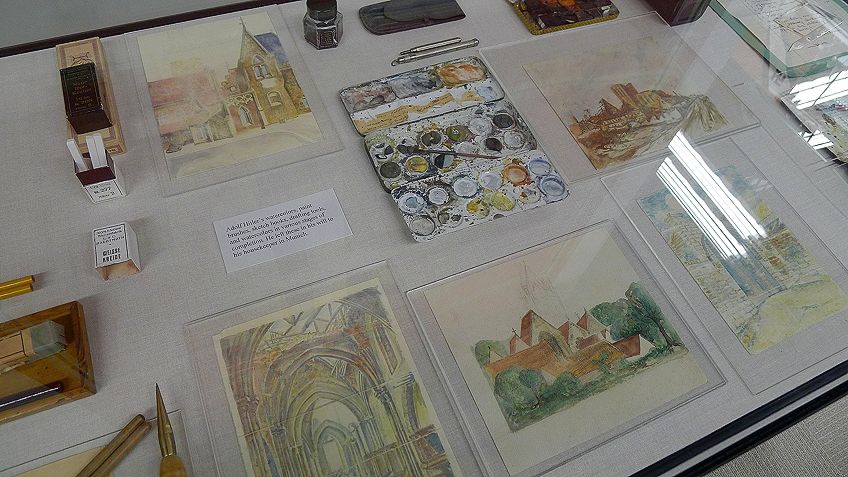 Adolf Hitler's watercolors, paintbrushes, sketchbooks, drafting tools, and watercolors in various stages of completion. He left these in his will to his housekeeper in Munich; leewrightonflickr, CC By 2.0, via Wikimedia Commons
Adolf Hitler's watercolors, paintbrushes, sketchbooks, drafting tools, and watercolors in various stages of completion. He left these in his will to his housekeeper in Munich; leewrightonflickr, CC By 2.0, via Wikimedia Commons
As delusional as he was in many other parts of his life, some of Hitler's personal documents and journals reveal that he did at least take his dedication to the arts rather seriously. Many of Hitler's paintings, such as The Courtyard of the Old Residency in Munich (1914), reveal his desire for purified scenery and clinical perfection that permeated beyond his fine art and into every psychological and political sphere of his life as well.
The Influences and Style of Hitler'south Paintings
Due to his technical education and desire for cold perfection, his paintings are very calculated apropos the representation of architecture. He did non, however, seem to limited a desire or ability to progress into a unique mode, merely copied the works of the masters that preceded him in the 19th century.
He thought of himself as the embodiment and synthesis of many other art movements and styles, but his main influences were primarily drawn from Italian Renaissance art, Greco-Roman Classicism, and Neoclassicism, equally tin can be seen in Hitler's painting, Mother Mary with the Holy Child Jesus Christ (1913).
 Mother Mary with the Holy Child Jesus Christ(1913) by Adolf Hitler;Adolf Hitler, Public domain, via Wikimedia Eatables
Mother Mary with the Holy Child Jesus Christ(1913) by Adolf Hitler;Adolf Hitler, Public domain, via Wikimedia Eatables
It is said that he appreciated the symbolism and technical prowess of the master artists and called Rudolf von Alt his biggest instructor. There are a few similarities between the two artists' work, but von Alt's piece of work displays an equal focus on the natural groundwork elements as on the focus on architecture.
Why Is It And then Hard to Verify Hitler'southward Artwork?
Stephan Klingen from the Fundamental Found for Art History in Munich has answered that question by stating that it is hard to verify Hitler's style considering he doesn't accept one. Hitler's artwork has been described equally belonging to a moderately aggressive amateur artist with no discernible unique character or technique that could exist seen equally recognizable hallmarks of his specific manner.
Zippo makes his work stand out from the thousands of similarly themed works of the period or region. This is also because the paintings by Hitler were already copies of other paintings done by German artists that he took from postcards, and was thus applying his limited skillset to someone else'due south existing work.
Due to the lack of identifiable artistic elements that could exist considered conclusively as i of his works, Hitler'south artwork has been the endless subject of forgery.
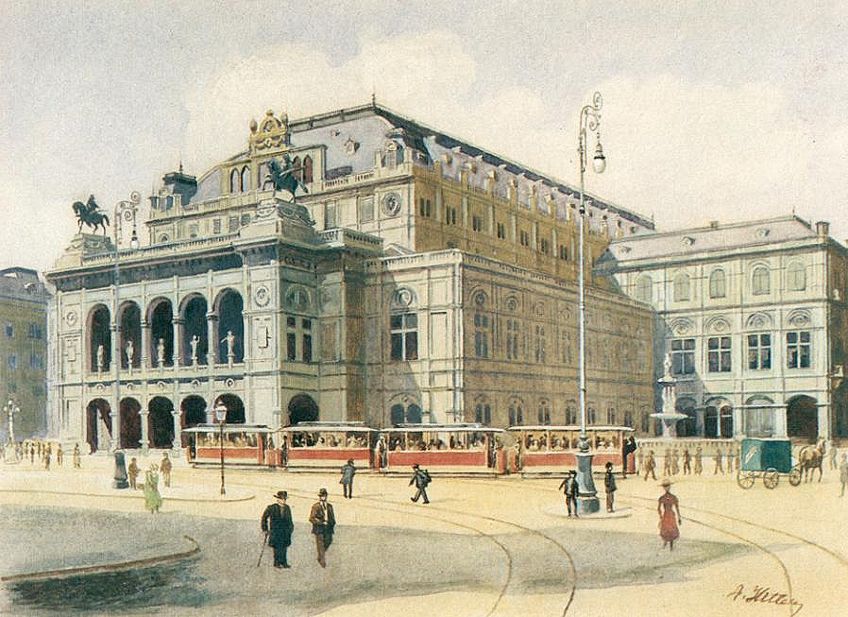 Vienna Country Opera(1912) by Adolf Hitler;Adolf Hitler, Public domain, via Wikimedia Commons
Vienna Country Opera(1912) by Adolf Hitler;Adolf Hitler, Public domain, via Wikimedia Commons
Another art critic from America, John Gunther, wrote about Hitler's paintings saying that he felt his artwork was easily forged because it was utterly devoid of unique artistic rhythm, lacked color, was boring to wait at, and lacked spiritual feeling or imagination. He described them as the painfully precise work of an architect's draftsmanship, not the piece of work of truthful talent or a unique creative person. Information technology was lilliputian wonder that the professors in Vienna had suggested staying within the confines of the rigid architectural school of design.
Every bit recently equally 2019, Hitler's art yet receives scathing reviews from art critics such as Jerry Saltz, who described Hitler'southward drawings and art as being spatially dead and academically generic. Saltz went on to explain that if anything, Hitler but barely managed to ape the penmanship of the ameliorate artists he copied from postcards. He was perhaps an adequate draftsman, simply as an artist, he was utterly unimaginative.
An art critic was one time shown some of Hitler's paintings without revealing who the creative person was and was asked for his frank opinion on the art.
The critic remarked that they were "quite good" but upon further examination, he stated that by the way the artist drew the humans in his paintings, the artist seemed to display a disinterest with the human race. Scholars tend to agree with this statement, noting that Hitler'south works reveal sociopathic tendencies; many of his landscapes were created with a sterile and uniform look, where the grandeur of stately architecture and nature take precedence over the humans in the paintings, who tend to be portrayed rather nondescript. An example of this can be seen in his work, Hofbräuhaus, Munich (c. 1919), which is where Hitler kickoff founded the Nazi party.
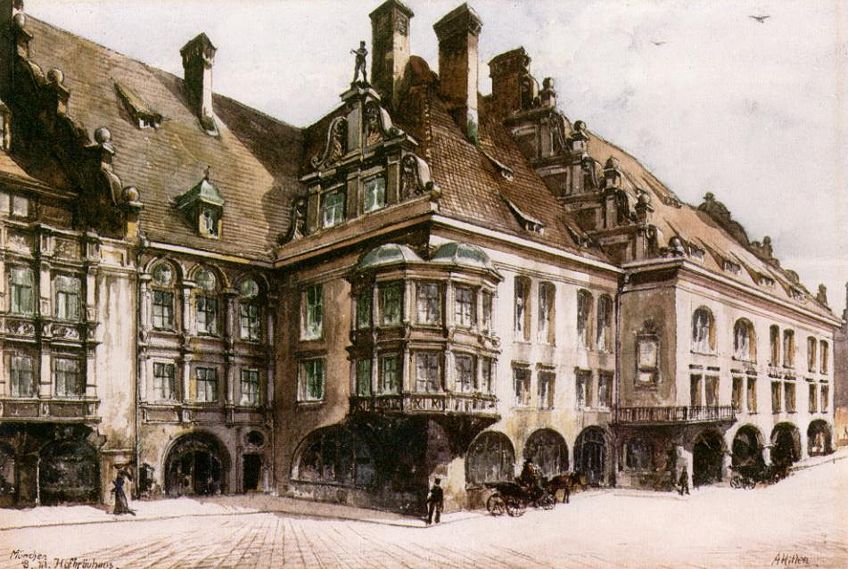 Hofbräuhaus, Munich(c. 1919) by Adolf Hitler;Adolf Hitler, Public domain, via Wikimedia Commons
Hofbräuhaus, Munich(c. 1919) by Adolf Hitler;Adolf Hitler, Public domain, via Wikimedia Commons
Sale Sales
Besides the many paintings by Hitler that were taken out of circulation past the Nazis, many of Hitler'south paintings were confiscated by the U.s.a. army at the end of the 2d World War along with other captured objects, who have been determined that they remain unexhibited. Other paintings by Hitler are housed in private collections, many of which began to be sold in sale houses in the 2000s.
Mullock's auction house sold xv of Hilter's paintings for $145,358 in 2009, while Ludlow's auction house sold 13 paintings by Hitler for over 100,000 Euro.
A mixed-media artwork of Hitler'due south entitled Maritime Nocturno (1913) sold for 32,000 Euro at an auction in Slovakia in 2012, and in 2014, a watercolor of the erstwhile Munich registry function entitled Standesamt und Altes Rathaus München(1914) sold in an sale in Nuremberg for 130,000 Euro. The sale included a letter signed past Albert Bormann for authenticity also every bit a bill of sale, both of which could have added to the high asking price of the artwork. Mullock'south sold a further two oil paintings in 2017, one depicting a lake house entitled Firm at a Lake with Two Mountains (1910)
Scholars have estimated that Hitler only created about 300 works during his lifetime. Hitler's own words throw this statement into dubiety in his autobiography Mein Kampf where he states that he painted around two to three paintings on average per mean solar day in Vienna. It has been estimated that he must have made between 600 to over thou paintings during his fourth dimension in Vienna alone.
This estimate was put forwards by Peter Jahn, an expert in Hitler'southward artwork who was i of the people assigned by Hitler to locate and retrieve the paintings that he had painted between 1907 and 1922, which he did for four years until being chosen into military service. Peter Jahn later became the art consultant in 1937 for the German Embassy in Vienna.
There, he was meant to find and destroy Hitler's artworks, although he ended upward selling one of the biggest collections of paintings by Hitler.
This consisted of around 18 of Hitler's paintings, which were sold for approximately $50,000 each. The biggest private drove is currently housed in Natick, Massachusetts in the US, at the International Museum of World War II.
Paintings past Hitler
Hitler painted mainly in watercolor and used it to express his passion for painting scenery and architecture. Critics have noted that his draftsman's eye for detail was concentrated mainly on the buildings of his landscapes and that the passion for detail did not extend to the surrounding natural elements, such as the trees and mountains surrounding the compages and on the periphery of the canvas' view.
An example of a watercolor painting by Adolf Hitler isThe Courtyard of the Sometime Residency in Munich painted in 1914. It depicts the onetime court of Alter Hof, which is situated in the center of Munich and was the residence of the Holy Roman Emperor, Louis 4.
This painting was produced during Hitler's early years equally a struggling creative person living in Munich earlier he volunteered for the army.
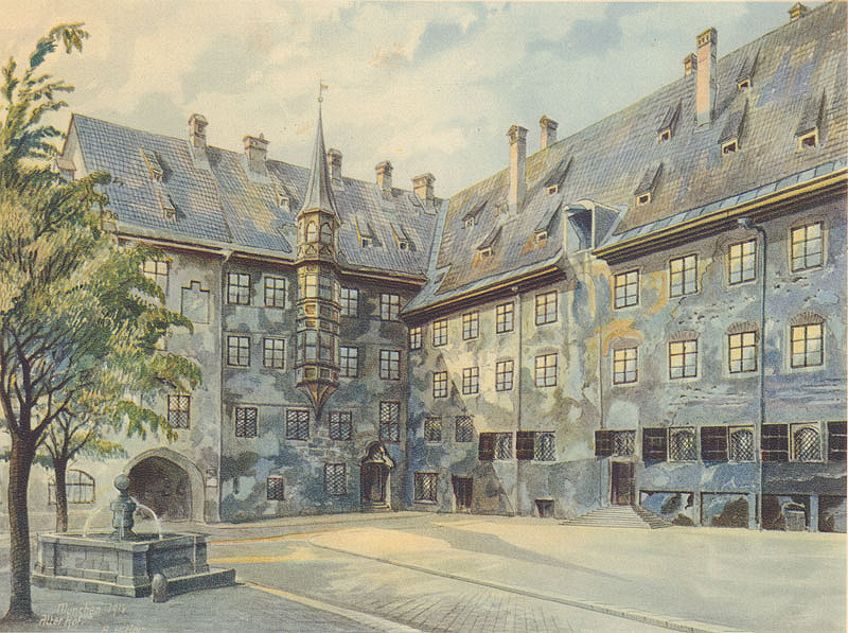 The Courtyard of the Old Residency in Munich(1914) by Adolf Hitler;Adolf Hitler, Public domain, via Wikimedia Commons
The Courtyard of the Old Residency in Munich(1914) by Adolf Hitler;Adolf Hitler, Public domain, via Wikimedia Commons
As with many of his works, the painting reveals an agreement of architectural design and strict form of line and construction, but where the building has been recreated with immaculate attention to sure details, other aspects like the tree remain largely stylized and without any great attending to texture or shading of natural objects in the composition. There is as well a water fountain painted on the left of the canvass. The Courtyard of the One-time Residency in Munich is one of the paintings kept in a collection at the Army Center of Military History, archived and stored far away from public view.
The Moral Implications of the Sale of Hitler's Paintings
In 2015, 14 paintings by Hitler were sold at the Weidler sale house in Nuremberg for $440,000. The drove of Hitler's drawings and paintings included portrayals of naked women, flowers, and castles and were produced between 1904 and 1922. Bids arrived from countries such as the United Arab Emirates, French republic, Prc, Brazil, and Germany, despite being admittedly unimpressive equally works of art. Much controversy arose over the profits earned by the auction house from the fine art of one of the world'south almost notorious dictators and mass murderers.
None of the bidders were particularly interested in Hitler'south ability to paint, but rather the value of the signature attached to it.
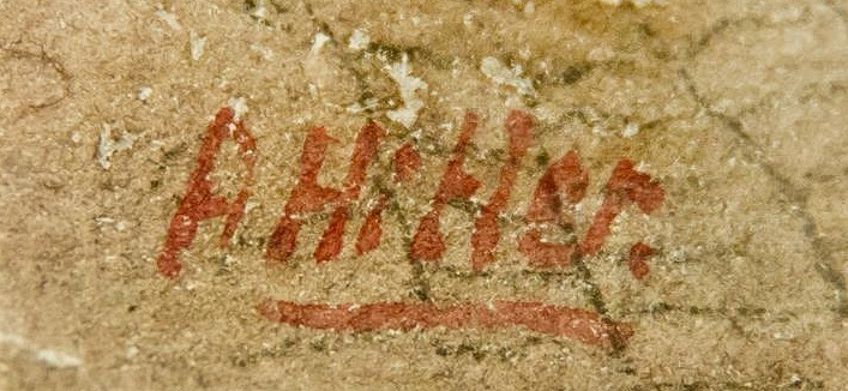 Signature of Adolf Hitler from 1 of his paintings;Adolf Hitler, Public domain, via Wikimedia Eatables
Signature of Adolf Hitler from 1 of his paintings;Adolf Hitler, Public domain, via Wikimedia Eatables
Many people felt that the money raised should have gone to a charity, simply it soon became apparent that no charity wanted to receive money that was in any mode connected to Hitler. It is highly frowned upon in Germany to be seen making money from the Nazi leader'southward work. For example, the state archive of Bavaria refuses to buy any paintings by Hitler simply will accept them as a donation to remove them from the art circuit and full general public circulation. Despite the moral and ethical concerns voiced by members of the public, no law prohibits the sale of Hilter'south paintings every bit long as they do not portray any Nazi symbolism such as swastikas.
Today, we have learned more about the bottom-known side of Adolf Hitler, i of the cruellest dictators the world has ever known. From his tumultuous family upbringing with a begetter that refused to acknowledge his artistic talents, to the professors of academic institutions who failed to find whatever streak of artistic value in his work, as wellas the art critics who establish his work dull and unoriginal, it seems that Hitler'due south career and passion for fine art was doomed from the outset. Still despite everything working confronting him, he sought to make a living on the streets of Vienna and Munich before volunteering for War machine service. Even later on becoming the leader of a huge empire, the greatest monster in the world notwithstanding liked to tinker with watercolors in his spare time, an indication that behind the angry and difficult exterior of a savage mass murderer was the soul of a boy who just wanted to paint and lose himself in art.
Take a wait at our famous Hitler paintings webstory here!
Frequently Asked Questions
What Themes and Subjects Did Adolf Hitler Paint?
Adolf Hitler showed a preference for traditional themes and styles. In his early days on the streets of Venice, he mostly painted cityscapes that he copied from postcards. The pictures on the postcards themselves were painted by other German painters. Other subjects that Hitler liked to paint were female nudes and flowers. Nigh of his works show a preference for landscapes that reflect his desire for sterile clinical perfection, and much of his inner psyche is revealed by the fact that he painted with little or no attention paid towards the human being figures in his compositions.
Where Are Hitler'due south Artworks Now?
Many of Hitler'southward works were destroyed by members of the Nazi regime under the society of Hitler himself. Those that remained found their mode into individual collections and were also stored and archived by certain branches of the United States Military complex, where they remain out of circulation and out of the public eye. Although many of Hitler's paintings have been sold at great profit, many people remain hugely opposed to others profiting off the dictator's work.
priestleythenficed.blogspot.com
Source: https://artincontext.org/hitler-paintings/